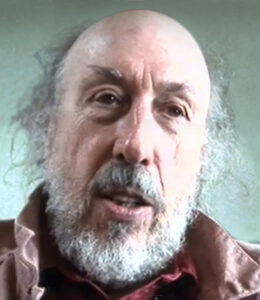
Richard Hamilton (1922-2011) the London born, English painter and collage artist is considered the founder of the Pop art movement. Some of his most famous works include the collages Just what is it that makes today’s home so different, so appealing? (1956)one of his earliest works, My Marilyn (Paste Up) (1965), and the cover design for the Beatles’ White Album (1968).
Just what is it that makes today’s home so different, so appealing? 1956. Richard Hamilton. Kunsthalle Tübingen, Tübingen. One of Hamilton’s earliest works.
The Early Years and Richard Hamilton
Hamilton was born to be an artist. About his early childhood achievements in art Richard Hamilton would later say, “I suppose I was a misfit. I decided I was interested in drawing when I was 10. I saw a notice in the library advertising art classes. The teacher told me that he couldn’t take me – these were adult classes, I was too young – but when he saw my drawing, he told me that I might as well come back next week.”
After working as a technical draftsman, Richard Hamilton enrolled at the Royal Academy School, in London. He later enrolled at Slade School of Art, where he studied painting with instructor William Coldstream.
The Independent Group and Richard Hamilton
Early in his career Richard Hamilton met and befriended other artists including Eduardo Paolozzi. The two were part of the Independent Group. This art centric group formed in London, in the early 1950s and included art critic Lawrence Alloway, architects Alison and Peter Smith, Richard Hamilton, and Paolozzi.
The Independent Group held meetings to discuss popular culture including, films, books, advertising, and innovative technologies in household appliances.
Richard Hamilton was inspired by the works of Paolozzi, especially collages he had started in the late 1940s. Paolozzi presented these at a meeting of the Independent Group, in 1952. Richard Hamilton would take the Pop art movement and expand it.
A Brief History of Pop Art
The Pop art movement provided a radical shift in what was considered art, by blending fine art and popular culture. It focused on consumerism, advertising, popular images in magazines and comic strips, current events, and celebrities.
Although Pop art has its roots in England, it has always focused on the habits and lifestyle of the American consumer. The Pop art movement quickly spread to New York and later Los Angeles.
For more information, see our article on the History of Pop Art.
Richard Hamilton Pre-Pop Art
Richard Hamilton worked for the Institute of Contemporary Arts after graduating from Slade. The mandate of ICA was to present ground-breaking art shows. Richard Hamilton was instrumental in making this happen, as he oversaw both design and installation.
ICA exhibited Man, Machine and Motion in 1955. Here, Richard Hamilton clipped images and attached them onto portable steel frames. The 220 images ranged from early Renaissance technical drawings, to what the latest advancements were in automobiles and spacecrafts.
Richard Hamilton and The Pop Art Breakthrough
This is Tomorrow, a breakthrough exhibit at White Chapel Art Gallery, in London’s East End, in 1956, is today considered the official start of the Pop art movement as a collective. This proto-Pop art installation featured the works of painters, sculptures, and architects.
Richard Hamilton designed the poster for the exhibit, which later was known as his seminal collage artwork, Just what is it that makes today’s home so different, so appealing? (1956). The early work poster was reproduced in the accompanying catalogue for This is Tomorrow in black and white.
Also, part of this exhibit was the collaborative early work between Richard Hamilton and architect John Voelcker called Funhouse (1956).
Richard Hamilton would soon after describe Pop art as “Pop art is: Popular, transient, expendable, low-cost, mass-produced, young, witty, sexy, gimmicky, glamorous, and Big Business.” This captured the spirit of the Pop art movement and is now the standard definition.
Richard Hamilton and Teaching
After This is Tomorrow, the highly acclaimed show, Richard Hamilton was offered a teaching position at the Royal Academy of Art, from 1957-1961, where future Pop art artists Peter Blake and David Hockney were among his students.
Through his connections at ICA, Richard Hamilton was given a teaching post at Durham University, in the Department of Fine Art, in Newcastle, where he taught until 1966.
Art, Music, and Richard Hamilton
Bryan Ferry, who later formed Roxy Music was one of Hamilton’s students, in Newcastle. Through the friendship that developed, Richard Hamilton met Paul McCartney. Richard Hamilton designed the cover Beatles’ White Album, in 1968. This was a major cross over between Pop art and pop music.
Richard Hamilton also met other musicians through his art agent Robert Fraser, such as lead singer of the Rolling Stones, Mick Jagger.
Just what is it that makes today’s homes so different, so appealing? (1956)
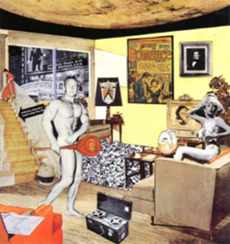
Just what is it that makes today’s home so different, so appealing? by English Pop art artist Richard Hamilton (1922-2011) is often called genius in the Pop art world. One of his earliest works, using images from illustrated American magazines for the early work collage, Richard Hamilton took the title of the work was taken directly from an advertisement in a 1955 copy of Ladies’ Home Journal. The setting for the room came from an ad for Armstrong Floors.
A husband and wife are surrounded by luxury furniture. The muscular man is naked, except for a strategically placed lollipop, with the word POP on it. The oversized lollipop Richard Hamilton added has been likened to future sculptures by Swiss American Pop art artist Claes Oldenburg.
The glamorized wife poses like a 1950s pin-up girl and wears pasties over her nipples. There is a television playing in the background, and a large tape recorder at the man’s feet.
On the walls, Richard Hamilton hangs a Victorian portrait, representing the past, a crest from the Ford Motor Company, and a poster from a modern-day comic book called Young Romance. It has been noted that adding the comic book element occurred years before American Pop art artist Roy Lichtenstein, started incorporating the same Young Romance comics into his work.
The same can be said about the grocery store ready canned ham, which also appears in Just what is it that makes today’s homes so different, so appealing?. American Pop art artist Andy Warhol later included grocery shelf products in his artwork, as a criticism on consumer products and consumption.
At the upper right of Just what is it that makes today’s homes so different, so appealing?, is a woman cleaning in a red dress, using a vacuum cleaner, with an impossibly long hose, reaching to the very top of the stairs. These innovative technologies were all in demand to make life easier.
Fun House (1956)
The collaborative early work between Richard Hamilton and John Voelcker caused a sensation at the This is Tomorrow (1956) art exhibit. The structure was built by Voelcker. Then, Richard Hamilton created the assemblage, taking a variety of images from conventional art, as well as films, comic books and advertising. The multi-media installation included a large, inflated bottle of the popular Guinness beer, along with a jukebox playing the latest hits. The duo also borrowed a model of Robbie the Robot, standing 16 feet high, from the film set of MGM’s Forbidden Planet. Its eyes flashed at the audience, while its voice was recorded and played for the event.
Hommage à Chrysler Corp. (1957)
Against a painted beige background, Richard Hamilton depicts the hood of a car and a woman leaning against it in Hommage à Chrysler Corp (1957). She is a mere outline in black and white, with bright red lips inspired by Voluptua a character on American television.
The design of her breast was taken from the ads for Exquisite Form Bra. Both elements Richard Hamilton included direct the viewer to the woman, who would otherwise remain almost invisible.
The car is outlined in pink and grey paint, with the suggestion on a headlight. Richard Hamilton merges together both the woman and the car.
The artwork as it appears today, is not how Richard Hamilton originally created his work. Time has damaged it.
Metal foil that was part of the finished work in 1957 is now missing. An enlarged photo of the air from a jet car had been pasted. Later, it started to detach. Richard Hamilton replaced this in 1996, with another image, a digital scan of the original.
Today, the oil paint, metal foil and digital print on wood artwork by Richard Hamilton is part of the Collection of the Tate Gallery, London, United Kingdom.
Towards a definitive statement of the coming trends in menswear and accessories (1962) Richard Hamilton
Poking fun at masculinity with Towards a definitive statement of the coming trends in menswear and accessories (1962), Richard Hamilton depicts then American President John F. Kennedy in an astronaut’s helmet. The Americans were trying to dominate developments in space and here the artist draws attention to this. This Richard Hamilton work of paint and printed paper on wood is part of the Collection of the Tate Gallery, London, United Kingdom.
Richard Hamilton and Interior (1964-1965)
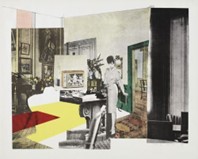
The inspiration for this Richard Hamilton work, comprised of screenprint on paper, part of The Collection of the Tate Gallery, in London, United Kingdom, was the film Shockproof, a movie by German director Douglas Sirk, in 1949. The idea Richard Hamilton had was to create an ominous room that was unsettling to the viewer, using photographs and advertisements, once again pulled from American magazines.
My Marilyn (Paste Up) (1965) by Richard Hamilton
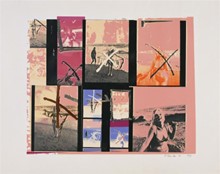
This screenprint work by Richard Hamilton, in the Museum of Modern Art, in New York, was created after the suicide of Marilyn Monroe. Here, Richard Hamilton takes multiple publicity photos that appeared in a British magazine after her death. The black and white photos, of the actress posing on a beach in a bikini are washed with pink, blue and orange.
Most of the images contain an x over them. The x was originally hand-drawn by Monroe. Richard Hamilton decided to keep her x , and not create his own. Instead, he enlarged the actress’s handwriting and used the techniques of masking, screening, and overprinting to include it.
Richard Hamilton and the Cover Design for the Beatles’ White Album (1968)
Richard Hamilton designed the album cover for the record entitled The Beatles. However, the design of an entirely white album, with just the title embossed, caused fans to simply call it the White Album.
Just what is it that makes today’s homes so different? (1992)
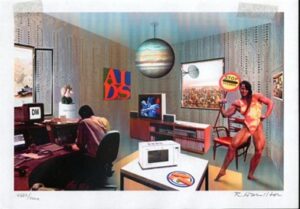
The BBC commissioned Richard Hamilton, in 1992, to recreate and update his original work Just what is it that makes today’s home so different, so appealing?, one of his earlier works from 1956. This time, the subject was a household in the 1990s.
Richard Hamilton chose to represent the man in the home as an accountant, and the woman as a body builder. The work was crafted as a digital collage using a Quantel Paintbox, which he had just started using in 1978.
The inspiration for the bedroom was pulled from a Spanish postcard. This was digitally scanned and enlarged. The wallpaper is from a scan of a circuit board. There are views from two windows. One shows a tank from the Gulf War, the other is a crowd of people from Ethiopia. A small bust of former Prime Minister Margaret Thatcher and is a microwave that sits on the table.
About using the Quantel Paintbox Richard Hamilton said, “My learning curve was … like a vertical wall … Canon loaned a large copier which could also be used to print files sent to it from a computer. This was an ideal instrument to produce A4 proofs as my image developed. Looking for a subject, I turned to the old collage that seemed due for an update. It provided an opportunity to assess how life had changed since 1956, so the list of items I deemed of importance then would be a logical starting point: man, woman, humanity, history, food, newspapers, cinema, TV, telephone, comics, words, tape recording, cars, domestic appliances, space.”
The interview from which this is quoted was part of a six-part series called Painting by Light, featuring artists and computer technology from BBC.
Richard Hamilton and his Legacy
As the artists who established the future of the Pop Art Movement, Richard Hamilton influenced not only later artists in the British Pop art movement, such as Peter Blake and David Hockney, but he also inspired the American Pop art movement including artists like Andy Warhol and Roy Lichtenstein.
